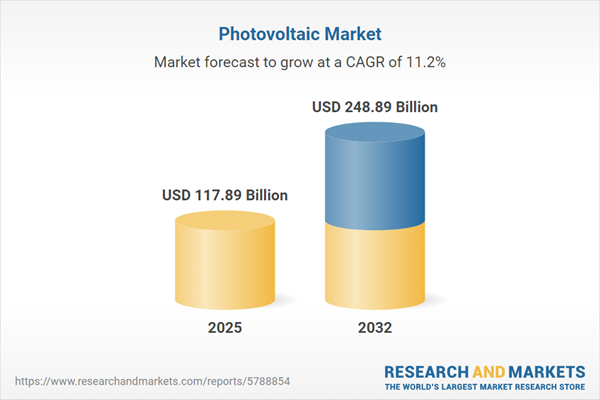Speak directly to the analyst to clarify any post sales queries you may have.
The photovoltaic market is entering a transformative phase, driven by ongoing technological advances and regulatory momentum. Senior leaders are now positioned to leverage a rapidly evolving energy sector characterized by growing demand, policy shifts, and expanding application opportunities.
Market Snapshot: Photovoltaic Market Size and Growth
The Photovoltaic Market grew from USD 106.65 billion in 2024 to USD 117.89 billion in 2025. It is expected to continue growing at a CAGR of 11.17%, reaching USD 248.89 billion by 2032. Trends signal elevated market uptake as digitalization, improving performance, and favorable regulations reinforce photovoltaic solutions in both developed and emerging economies. The sector’s scale and pace of expansion reveal strong momentum for forward-thinking organizations that adapt to fast-changing dynamics.
Scope & Segmentation
- Technology: Crystalline silicon (monocrystalline, polycrystalline); thin film (amorphous silicon, cadmium telluride, copper indium gallium selenide)
- Component: Inverters, modules, monitoring systems, mounting systems, photovoltaic cells
- Material: Glass, metal, polymer, silicon
- Installation Type: New installations, retrofits
- Integration Level: Building integrated photovoltaics, portable
- Tracking Mechanism: Dual axis, fixed tilt, single axis
- System Type: Grid-tied, off-grid
- Application: Commercial (educational, healthcare, hospitality, retail), industrial, residential, utility-scale
- Deployment: Floating solar panels, ground-mounted, rooftop
- Distribution Channel: Offline (direct sales, distributors/suppliers), online
- Regions: Americas (North America, Latin America), Europe, Middle East & Africa (Europe, Middle East, Africa), Asia-Pacific
- Key Companies: Includes ABB Ltd., Adani Group, Canadian Solar Inc., First Solar, Inc., Huawei Technologies Co., Ltd., SMA Solar Technology AG, Trina Solar Co., Ltd., and others
Key Takeaways for Decision-Makers
- Technological innovation across photovoltaic modules, system integration, and digital monitoring is ensuring greater efficiency and reliability for project developers and end users.
- Policy incentives and regulatory mandates continue to lower entry barriers, accelerating both commercial and residential adoption across diverse regions.
- Emerging business models such as power purchase agreements, community solar programs, and integrated energy-as-a-service platforms foster wider participation in solar generation.
- Integration of energy storage and demand-response capabilities with photovoltaic assets is opening new avenues for resilience and grid stability.
- Segment diversity—from advanced materials to application-specific systems—provides targeted pathways for manufacturers and service providers seeking competitive differentiation.
- Regional variations highlight the importance of adapting strategies to align with local regulations, resource endowments, and infrastructure development for sustained growth.
Tariff Impact: Implications of United States Trade Measures
New tariffs on photovoltaic imports introduced in the United States in 2025 have altered supply chain strategies and project cost structures. Firms have responded with hybrid procurement—balancing domestic sourcing with imports from tariff-exempt locations—while domestic manufacturing initiatives gain traction. This strategic adaptation has led to industry-wide reassessment of capital expenditures, joint ventures, and localization to manage policy-driven risk and maintain project viability.
Methodology & Data Sources
The insights in this report are built on primary research—including interviews with manufacturers, project developers, utilities, and regulators—combined with secondary data from energy reports, regulatory filings, industry whitepapers, and proprietary trade data. Our triangulation approach and expert reviews reinforce accuracy, while structured segmentation analysis enables nuanced understanding of historical trends, cost drivers, and deployment models.
Why This Report Matters
- Empowers executives to assess regional, technological, and regulatory trends for informed investment and market entry strategies.
- Supports risk mitigation planning through in-depth analysis of the implications of tariffs and evolving policy incentives.
- Delivers actionable intelligence to identify new growth avenues, segment-specific opportunities, and potential partnership models in the photovoltaic space.
Conclusion
This report equips leaders with a clear strategic playbook to navigate transformation in the photovoltaic industry. Informed decision-making and agile execution are key to capitalizing on the transition toward a lower-carbon global energy sector.
Additional Product Information:
- Purchase of this report includes 1 year online access with quarterly updates.
- This report can be updated on request. Please contact our Customer Experience team using the Ask a Question widget on our website.
Table of Contents
3. Executive Summary
4. Market Overview
7. Cumulative Impact of Artificial Intelligence 2025
Companies Mentioned
The companies profiled in this Photovoltaic market report include:- ABB Ltd.
- Acciona, S.A.
- Adani Group
- AllEarth Renewables, Inc.
- Array Technologies, Inc.
- Astronergy by CHINT Group Corporation
- Canadian Solar Inc.
- Chint Solar (Zhejiang) Co., Ltd.
- Cox Energy S.A.B.
- Eaton Corporation PLC
- Emmvee Photovoltaic Power Pvt. Ltd.
- FIMER S.p.a.
- First Solar, Inc.
- GCL Integration Technology Co., Ltd.
- Huawei Technologies Co., Ltd.
- JA Solar Technology Co., Ltd.
- Jakson Group
- Kaneka Corporation
- Kyocera Corporation
- Loom Solar Pvt. Ltd.
- Masdar
- Mission Solar Energy LLC
- Mitsubishi Electric Corporation
- Panasonic Holdings Corporation
- Photon Energy Systems Limited
- Q Cells by Hanwha Group
- Sharp Corporation
- Shunfeng International Clean Energy Co., Ltd.
- Silfab Solar Inc.
- SMA Solar Technology AG
- Solar Frontier Europe GmbH
- SolarEdge Technologies Inc.
- Sungrow Power Supply Co., Ltd.
- TATA Power Solar Systems Limited
- The Solaria Corporation
- TotalEnergies SE
- Trina Solar Co., Ltd.
- Vikram Solar Ltd.
- Waaree Energies Ltd.
Table Information
| Report Attribute | Details |
|---|---|
| No. of Pages | 181 |
| Published | November 2025 |
| Forecast Period | 2025 - 2032 |
| Estimated Market Value ( USD | $ 117.89 Billion |
| Forecasted Market Value ( USD | $ 248.89 Billion |
| Compound Annual Growth Rate | 11.1% |
| Regions Covered | Global |
| No. of Companies Mentioned | 40 |









